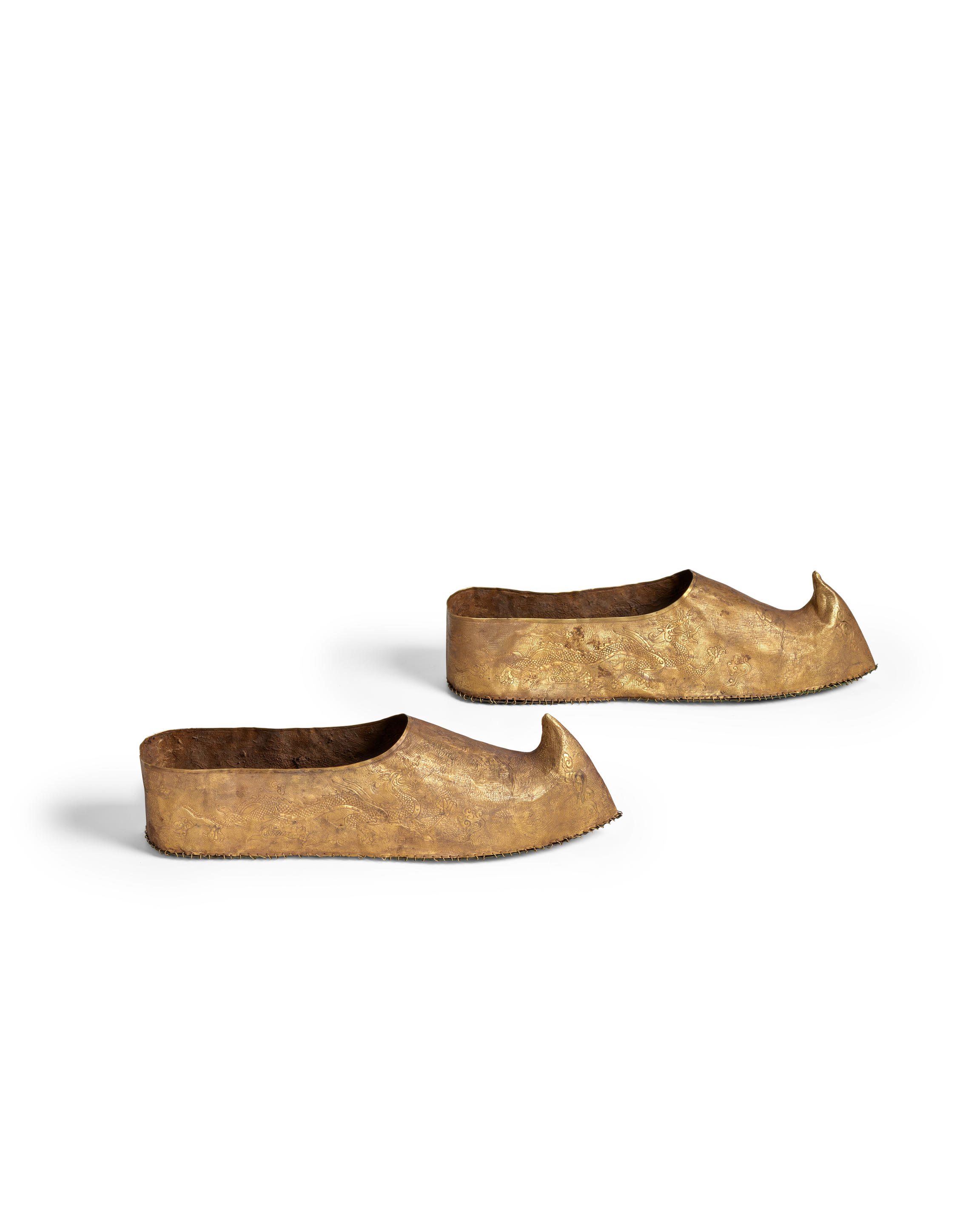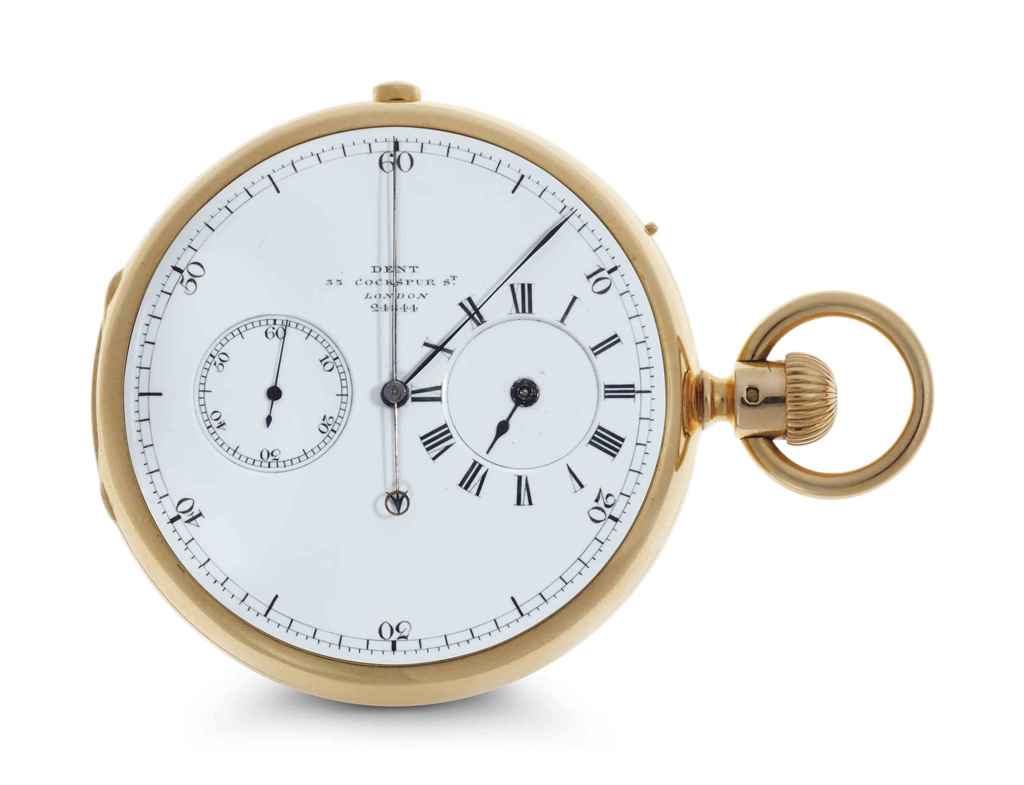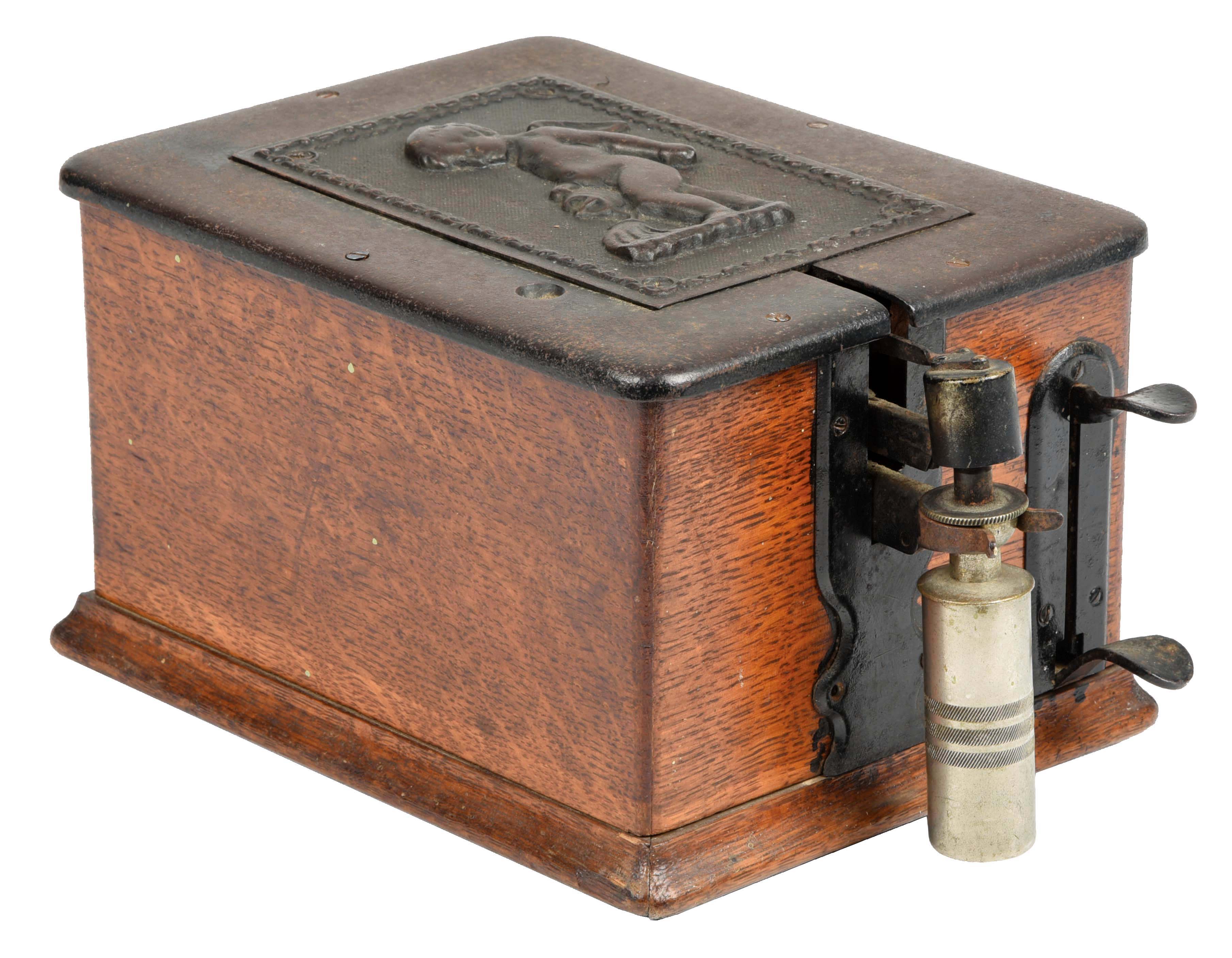A RARE AND UNUSUAL PAIR OF WOMEN'S GOLD SHOESLiao Dynasty
The elongated sides joined at the front and rounded with a hook-shaped tip, the thinly hammered gold sheet finely chased with 'phoenix and cloud' designs over a dense 'fish roe' ground, the upturned tip decorated with a flaming pearl above ruyi cloud scrolls, the bottom finished with a thin bronze sheet threaded with gold wires, the interior with remains of textile from burial.
11 1/4in (28.6cm) long (2).Footnotes遼 罕珍鏨金鳳雲紋女鞋
Provenance:
Rossi & Rossi, London, 2002
Loaned & Exhibited:
Los Angeles County Museum of Art, 29 January 2003 - 11 December 2008
Museum of Fine Arts, Houston, 2008-2023
來源:
倫敦Rossi & Rossi古董行,2002年
出借及展覽:
洛杉磯郡美術館,2003年1月29日 - 2008年12月11日
休斯敦美術館,2008 - 2023年
Gold shoes in a Liao context are very unusual, as the traditional footwear has always been boots, which were made of leather in real life, and made of gold and silver for the burial of the imperial family. As mentioned by Hiromi Kinoshita in Gilded Splendor: Treasures of China's Liao Empire (907-1125), New York, 2006, p. 104: "Boots were practical and necessary footwear for the seminomadic Khitan. They provided warmth and protected their wearers not only from the elements but also from chafing when riding. ... The high value the Khitan accorded to boots is recorded in Chinese texts when, in the eleventh century, the Song and Liao emperors exchanged leather boots and other luxurious goods as birthday gifts." The present examples, comprised of thinly hammered gold sheets with bronze soles, were made for royal burials. As shoes are a crucial part of an ensemble, they may suggest the owners' penchant toward domestic living rather than the mobile, active lifestyle on the Steppes. Khitan tomb decorations also reflected the Chinese influence on architecture – the burial chamber of the Princess of Chen (d. 1018) is in the shape of a yurt, while the decoration on top of the tomb gate reflects the architectural style of the Jin, who took inspiration from the Han Chinese.
A silk embroidered shoe with an up-pointed tip in the Mengdiexuan Collection is illustrated by Jenny F. So in Noble Riders from Pines and Deserts: The Artistic Legacy of the Qidan, Art Museum, The Chinese University of Hong Kong, 2004, pp. 94-95, no. II:4, also on pp. 54-55, figs. 10-11, noted by the author that "Liao shoes from archaeological excavations are very rare" and the only example was found at the Lindong site at Balin Left Banner, Inner Mongolia." See also a brocade woman's shoe with a deep upturned tip, closely related to the present example, discovered from the Southern Song tomb of Pan Ciming and his wife at Mishan, Lanxi, Zhejiang province, illustrated by Zhou and Gao, Zhongguo lidai funü zhuangshi [Women's Adornment and Dress throughout Chinese History], Taipei, 1988, p. 288, no. 408. (fig. 2)
It is exceedingly rare to see two pairs of gold shoes (the current lot and lot 94) of such close resemblance and exceptional workmanship, clearly made for a royal couple. Two iconographic elements connect these burial accessories: the dense ring-punched 'fish roe' ground, and the flaming pearl divided like a yin-yang symbol. (figs. 3, 4)
The layered leaf-like feathers on the phoenix's tail are another detail rarely seen, compared to the more common linear, wavy tail. According to Chunyan Wang in Liao dai jinyinqi yanjiu [Research on Liao Dynasty Gold and Silver], Beijing, 2020, pp. 192-193, the layered leaf-like tail was a typical motif of late Tang dynasty which was borrowed by the Liao. Another Liao example of leaf-like feather on the phoenix's tail is found in the silk kesi imperial boots in the collection of the Cleveland Museum of Art, published by James C. Y. Watt and Anne E. Wardwell, When Silk Was Gold: Central Asian and Chinese Textiles, New York, 1997, pp. 87-90, cat. no. 23, described by the authors as "two phoenixes diving in flight on either side of a flaming pearl. The phoenixes have crests, flowing head feathers, and magnificent plumed tails, while the flaming pearl is divided like a yin-yang symbol." (figs. 5, 6)
Scientific analysis for lot 94, A Rare and Unusual Pair of Man's Gold Shoes, is available upon request.
Fig 1: lot 93, one of the woman's shoes
Fig 2: woman's shoe from the Southern Song tomb of Pan Ciming and his wife, after Zhongguo lidai funü zhuangshi, Taipei, 1988
Fig 3: detail of lot 93, tip of the woman's gold shoe
Fig 4: detail of lot 94, vamp of the man's gold shoe
Fig 5: detail of lot 95, phoenix with a linear, wavy tail on the flap of the crown
Fig 6: detail of a kesi imperial boot, Cleveland Museum of Art, 1993.158.158a
A RARE AND UNUSUAL PAIR OF WOMEN'S GOLD SHOESLiao Dynasty
The elongated sides joined at the front and rounded with a hook-shaped tip, the thinly hammered gold sheet finely chased with 'phoenix and cloud' designs over a dense 'fish roe' ground, the upturned tip decorated with a flaming pearl above ruyi cloud scrolls, the bottom finished with a thin bronze sheet threaded with gold wires, the interior with remains of textile from burial.
11 1/4in (28.6cm) long (2).Footnotes遼 罕珍鏨金鳳雲紋女鞋
Provenance:
Rossi & Rossi, London, 2002
Loaned & Exhibited:
Los Angeles County Museum of Art, 29 January 2003 - 11 December 2008
Museum of Fine Arts, Houston, 2008-2023
來源:
倫敦Rossi & Rossi古董行,2002年
出借及展覽:
洛杉磯郡美術館,2003年1月29日 - 2008年12月11日
休斯敦美術館,2008 - 2023年
Gold shoes in a Liao context are very unusual, as the traditional footwear has always been boots, which were made of leather in real life, and made of gold and silver for the burial of the imperial family. As mentioned by Hiromi Kinoshita in Gilded Splendor: Treasures of China's Liao Empire (907-1125), New York, 2006, p. 104: "Boots were practical and necessary footwear for the seminomadic Khitan. They provided warmth and protected their wearers not only from the elements but also from chafing when riding. ... The high value the Khitan accorded to boots is recorded in Chinese texts when, in the eleventh century, the Song and Liao emperors exchanged leather boots and other luxurious goods as birthday gifts." The present examples, comprised of thinly hammered gold sheets with bronze soles, were made for royal burials. As shoes are a crucial part of an ensemble, they may suggest the owners' penchant toward domestic living rather than the mobile, active lifestyle on the Steppes. Khitan tomb decorations also reflected the Chinese influence on architecture – the burial chamber of the Princess of Chen (d. 1018) is in the shape of a yurt, while the decoration on top of the tomb gate reflects the architectural style of the Jin, who took inspiration from the Han Chinese.
A silk embroidered shoe with an up-pointed tip in the Mengdiexuan Collection is illustrated by Jenny F. So in Noble Riders from Pines and Deserts: The Artistic Legacy of the Qidan, Art Museum, The Chinese University of Hong Kong, 2004, pp. 94-95, no. II:4, also on pp. 54-55, figs. 10-11, noted by the author that "Liao shoes from archaeological excavations are very rare" and the only example was found at the Lindong site at Balin Left Banner, Inner Mongolia." See also a brocade woman's shoe with a deep upturned tip, closely related to the present example, discovered from the Southern Song tomb of Pan Ciming and his wife at Mishan, Lanxi, Zhejiang province, illustrated by Zhou and Gao, Zhongguo lidai funü zhuangshi [Women's Adornment and Dress throughout Chinese History], Taipei, 1988, p. 288, no. 408. (fig. 2)
It is exceedingly rare to see two pairs of gold shoes (the current lot and lot 94) of such close resemblance and exceptional workmanship, clearly made for a royal couple. Two iconographic elements connect these burial accessories: the dense ring-punched 'fish roe' ground, and the flaming pearl divided like a yin-yang symbol. (figs. 3, 4)
The layered leaf-like feathers on the phoenix's tail are another detail rarely seen, compared to the more common linear, wavy tail. According to Chunyan Wang in Liao dai jinyinqi yanjiu [Research on Liao Dynasty Gold and Silver], Beijing, 2020, pp. 192-193, the layered leaf-like tail was a typical motif of late Tang dynasty which was borrowed by the Liao. Another Liao example of leaf-like feather on the phoenix's tail is found in the silk kesi imperial boots in the collection of the Cleveland Museum of Art, published by James C. Y. Watt and Anne E. Wardwell, When Silk Was Gold: Central Asian and Chinese Textiles, New York, 1997, pp. 87-90, cat. no. 23, described by the authors as "two phoenixes diving in flight on either side of a flaming pearl. The phoenixes have crests, flowing head feathers, and magnificent plumed tails, while the flaming pearl is divided like a yin-yang symbol." (figs. 5, 6)
Scientific analysis for lot 94, A Rare and Unusual Pair of Man's Gold Shoes, is available upon request.
Fig 1: lot 93, one of the woman's shoes
Fig 2: woman's shoe from the Southern Song tomb of Pan Ciming and his wife, after Zhongguo lidai funü zhuangshi, Taipei, 1988
Fig 3: detail of lot 93, tip of the woman's gold shoe
Fig 4: detail of lot 94, vamp of the man's gold shoe
Fig 5: detail of lot 95, phoenix with a linear, wavy tail on the flap of the crown
Fig 6: detail of a kesi imperial boot, Cleveland Museum of Art, 1993.158.158a















Try LotSearch and its premium features for 7 days - without any costs!
Be notified automatically about new items in upcoming auctions.
Create an alert